Ever felt like your bedroom could use a splash of personality but didn’t want it to look like a rainbow exploded on your walls? Yeah, I’ve been there.
I’ve always believed a bedroom should feel like a reflection of you calm, cozy, yet full of character. But finding the sweet spot between playful color and stylish design can be tricky.
Over the years, I’ve experimented with bold choices and subtle tweaks, and let me tell you it is possible to have a vibrant bedroom that still feels curated. Here, I’m sharing five of my favorite colorful yet stylish bedroom design ideas that bring joy without overwhelming the space.
Bringing Bold Colors into Bedrooms Without Chaos
Adding color doesn’t mean surrendering to clutter or confusion. The key is balance. Color should guide your eye, lift your mood, and support a sense of harmony in the space. From personal experience, even small touches like trim or a ceiling can totally change the vibe of a room.
I used to think color had to be used sparingly in a bedroom to keep it “relaxing,” but with a bit of intention and the right combinations, bold color can actually enhance a peaceful atmosphere.
Here’s what’s worked beautifully for me (and what will work for you too):
1. Saturated Accent Walls with Natural Tones
One of the easiest ways I’ve added color without overwhelming the room is by painting just one wall a rich, deep hue. Think olive green, terracotta, navy blue, or warm plum. It adds instant depth. But here’s the trick: balance that saturated color with natural tones; light wood, soft linen, neutral bedding.
For example, in one of my guest bedrooms, I used a clay red on the wall behind the bed and paired it with rattan lamps and an off-white cotton duvet. The color draws you in, but it doesn’t feel heavy. It actually grounds the space.
What I love most is that an accent wall gives you all the drama without a full-room commitment. You still get the freshness of a neutral room but with way more personality.
Tips for choosing a color:
- Choose warm earthy shades if you want coziness.
- Cool, moody tones like navy or charcoal add sophistication.
- Always test your color in different lighting before painting.
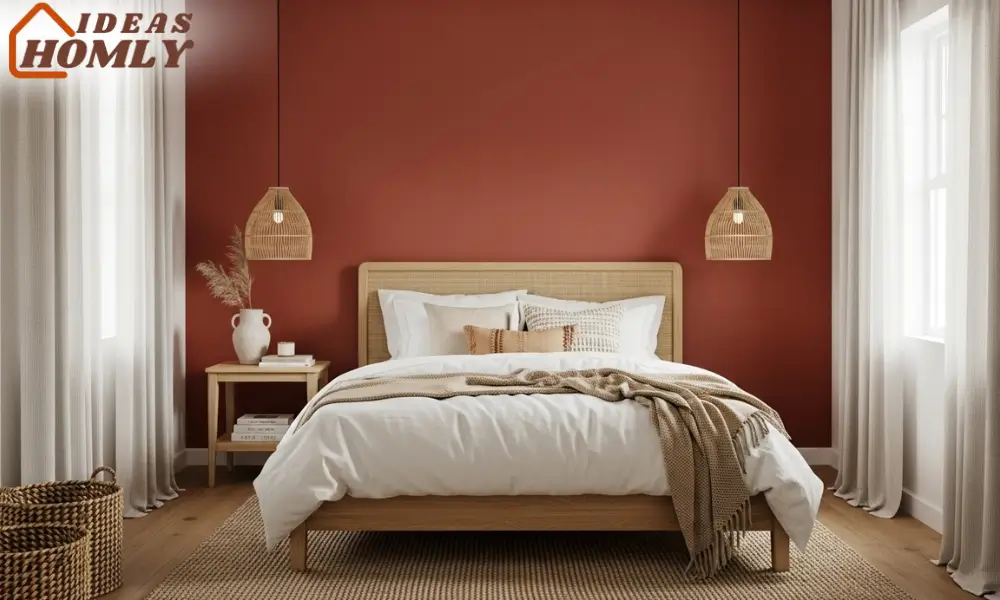
Here’s a quick comparison of saturated wall tones:
| Color Tone | Best Pairing | Mood it Creates |
|---|---|---|
| Deep Navy | Light woods, whites | Calm & modern |
| Olive Green | Beige, gold accents | Earthy & grounded |
| Terracotta | Creams, jute textures | Warm & welcoming |
| Charcoal Grey | Brass, soft pinks | Elegant & bold |
2. Color-Blocked Ceilings for Visual Impact
This one’s a secret weapon. When I first tried painting a ceiling a color other than white, I was nervous. But it totally transformed the room. A color-blocked ceiling adds unexpected drama, especially in smaller bedrooms where wall space is limited.
My favorite combo? A soft sage ceiling paired with white walls and sage pillows. It pulls the eye up and makes the room feel taller and more styled without needing extra furniture or accessories.
I’ve also done bold charcoal ceilings in rooms with high walls, which makes the space feel cozier and more intimate. The ceiling becomes a design element, not just a blank spot above your head.
The best part? It doesn’t clutter your line of sight. It just creates an impression of thoughtful design. And if you’re into minimalism, this is a brilliant way to add color without adding “stuff.”
A few color ceiling ideas to consider:
- Pale peach with white walls for a soft, romantic vibe
- Dusty blue for a fresh, airy look
- Forest green for a moody, modern finish
Stick to matte finishes to avoid unwanted shine. And always paint ceilings after walls, unless you like neck pain.
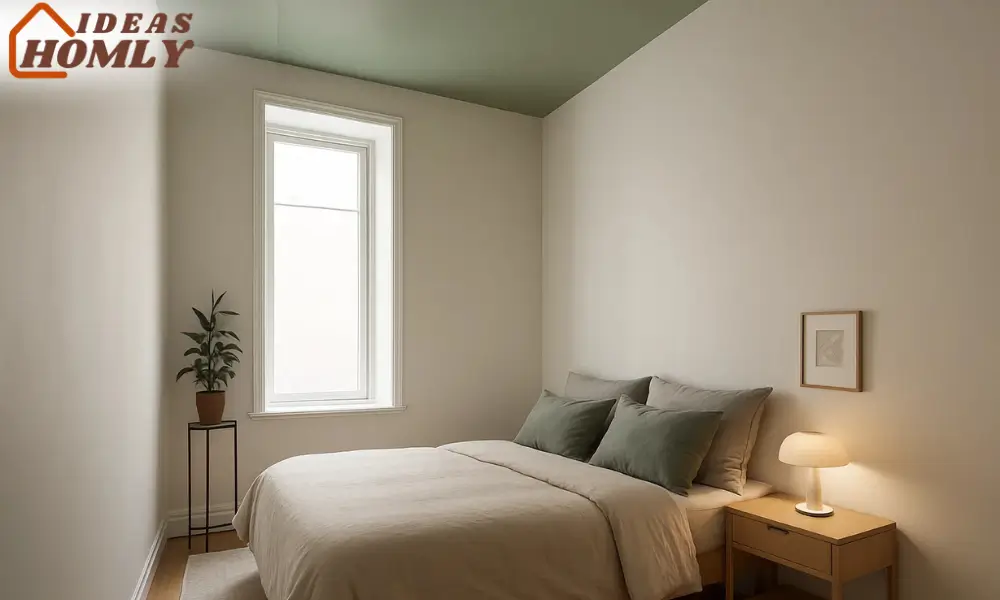
3. Graphic Trim and Bold Wallpaper
I used to think wallpaper was something my grandmother would’ve approved of floral patterns, pale pastels, and honestly, a little outdated. But wow, has it made a comeback. And not just in a vintage way.
I’m talking bold, graphic wallpaper and contrasting trims that create visual excitement without needing a single piece of wall art.
In my last bedroom makeover, I used a black-and-white geometric wallpaper just on the wall behind my dresser, and paired it with crisp black trim around the door frames and baseboards. It gave the space a boutique hotel feel, without spending boutique hotel money.
The key here is contrast and control. Keep the rest of the room simple so the wallpaper and trim can shine. Let them be the star of the show, while your textiles and accessories play the supporting role.
When choosing graphic wallpaper:
- Go for small-scale prints in small rooms
- Use bolder prints in well-lit or larger rooms
- Try peel-and-stick versions for commitment issues (guilty)
And if you’re not into full wallpapered walls, try using wallpaper inside wall panels or just halfway up the wall (a look that’s way more stylish than it sounds).
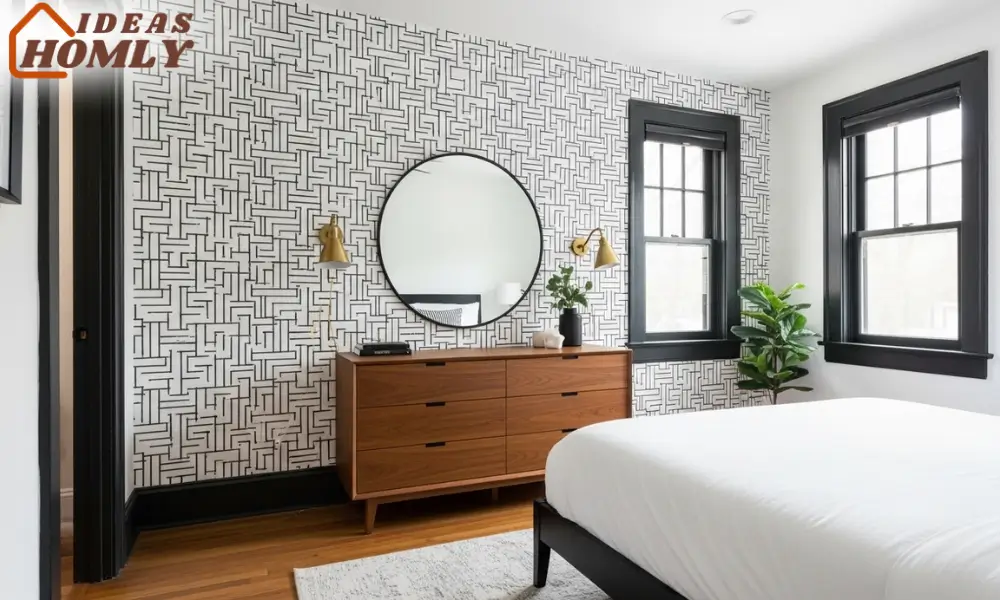
Quick style pairings:
| Trim Color | Best Wallpaper Match | Vibe it Gives |
|---|---|---|
| Black | White or neutral graphics | Modern & striking |
| Mustard yellow | Soft patterns or florals | Vintage & cheerful |
| Sage green | Earthy botanical prints | Calm & nature-inspired |
Don’t forget: trims don’t have to be boring. Paint them a color that pops, and suddenly your doors, windows, and even baseboards become part of the design.
4. Layered Accent Textiles for Flexibility
If commitment scares you (no judgment, same here), textiles are your best friend. Think cushions, throws, layered rugs, and even bed canopies. You can play with bold colors without touching a drop of paint.
In one of my own projects, I went all in with burnt orange, teal, and mustard pillows on a crisp white bed. Then I added a textured beige throw at the foot of the bed, and it all balanced out. The room looked fun, but not chaotic.
What’s great about this approach is how easy it is to swap out colors with the seasons. Bright coral for summer? Done. Moody plum for winter? Easy.
Key elements to layer:
- Throw pillows in different textures
- Knit or linen throws across the foot of the bed
- Flatwoven rugs under the bed or even layered over carpet
- Sheer curtains in soft pastels or prints
Another trick I swear by? Stick to a palette of 2-3 strong colors and repeat them in various places like curtains, cushions, and maybe a vase or two. It creates unity without feeling too matchy-matchy.
Layer rugs of different sizes to create a rich, lived-in look that feels both cozy and intentional. It works even better if you mix a neutral jute rug with a patterned runner.
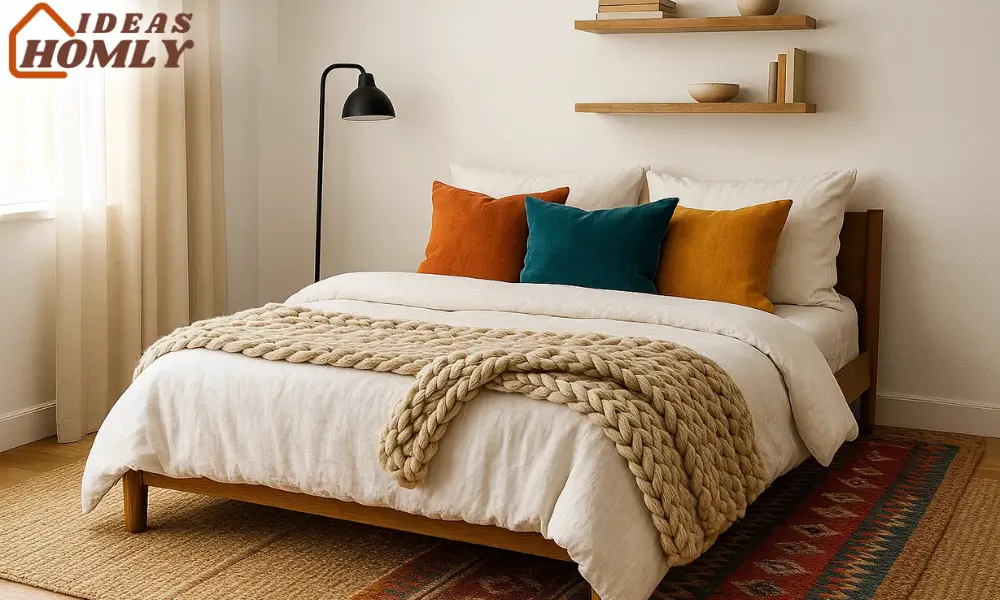
5. Complementary Pastel Combinations
Now, this might surprise you, but pastels don’t have to be sugary sweet or overly feminine. I used to stay away from them because I assumed they were too “soft.” But when you pair the right pastels, the result is anything but bland. They can actually look modern, even a little edgy.
One combo I’m currently obsessed with is muted mint green with soft peach. It feels airy and creative. I tried it in my home office corner of the bedroom, and the entire nook feels like a Pinterest board come to life.
Another favorite is lavender with pale gray, it’s subtle, but gives that soothing energy we all want in a bedroom after a long day of… you know, existing.
To avoid the room feeling too washed out, add structured elements like wood headboards, metal light fixtures, or sculptural vases. That way, the softness of the color doesn’t make the space feel too casual or childish.
Here’s a simple pastel palette guide:
| Pastel Combo | Works Best With | Style It Creates |
|---|---|---|
| Mint + Peach | Light wood, woven baskets | Fresh & playful |
| Lavender + Soft Grey | White linens, black metal | Calm & grown-up |
| Powder Blue + Beige | Brass accents, textured rugs | Relaxed & airy |
Pastels aren’t boring. When done right, they’re probably the most underrated color move in the bedroom world.
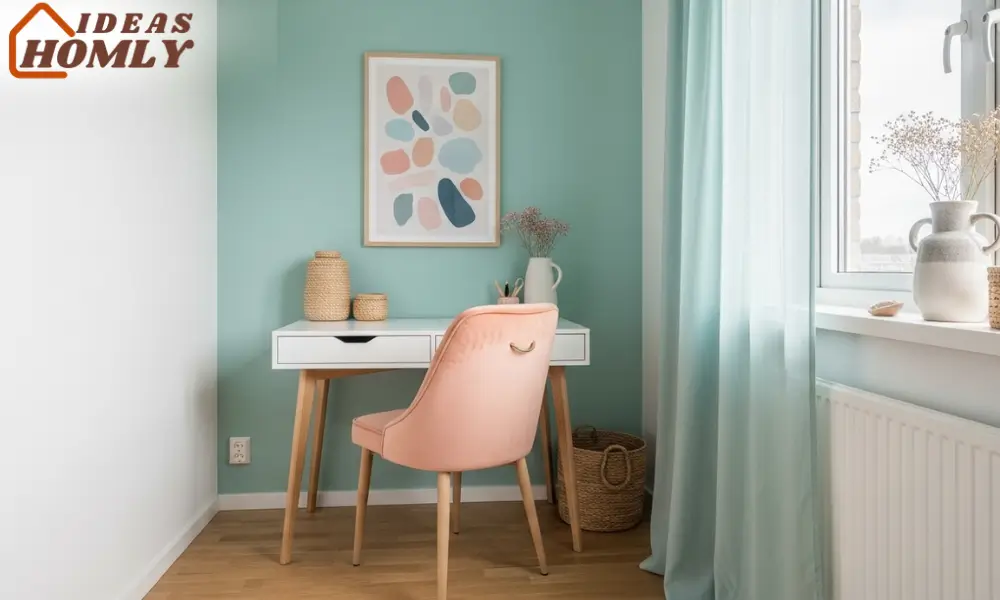
How to Balance Colorful Decor with Style
Alright, here’s the honest truth colorful bedrooms can go from fabulous to frenzied real fast. Been there, regretted that. Over the years, I’ve learned that bold design only works when it’s balanced with intention. Color should elevate the space, not dominate it.
The first thing I always do is pick a primary color, then let everything else support it. If I’m going big with a navy wall, the rest of the room stays calm think light wood furniture, white bedding, maybe a pop of gold in the lamp base.
Next, I make sure there’s a mix of textures and materials. Color alone can’t carry the vibe, you need softness, structure, and contrast. A velvet pillow, a woven rug, a smooth ceramic vase… these little things add richness without shouting for attention.
Lighting is also a big deal. Warm-toned light softens bold colors and makes the room feel inviting. I avoid bright white bulbs, they can make deep tones look harsh or even a little tacky (yikes).
If you want your colorful space to feel chic, here’s what always works for me:
- Limit your palette to 2 bolds + 1 neutral
- Let one element (wall, rug, bedding) be the star
- Use wood, linen, and metal to bring balance
- Add white space literally. Empty areas matter too
Sometimes, the most stylish choice is knowing when to stop. Let color lead, but don’t let it shout over everything else.
Conclusion
If you’ve made it this far, you probably love color as much as I do. And I get it color makes a space feel alive. But after designing several bedrooms for myself and others, here’s what I’ve learned:
Style isn’t about how loud your color is. It’s about how thoughtfully you use it.
Whether it’s a bold ceiling, a patterned wallpaper, or a mint-pink pastel pairing, colorful bedroom decor doesn’t have to mean chaos. With the right touches and a little balance, you can create a bedroom that feels personal, polished, and full of life.
So go ahead pick up that paintbrush, add that fuchsia throw, say yes to the emerald pillow. Just do it with style, intention, and maybe a little sass. Trust me, your future self (and your Pinterest board) will thank you.
FAQs
Even with bold colors, your bedroom can still feel calm. The secret is to choose soothing undertones—like muted blues, earthy greens, or terracotta and balance them with soft lighting and simple decor. Keep furniture and bedding neutral to avoid overstimulation. And always add cozy textures like throws or curtains to soften the look.
In smaller bedrooms, avoid using dark shades on all walls, it can make the space feel even tighter. Bright neon colors can also feel too harsh. Instead, use light to mid-tone colors like powder blue, sage green, or soft lavender. You can still include deep tones, but keep them as accents rather than covering the whole room.
Yes, but with caution. Stick to a maximum of two bold colors, and let the rest of the room remain neutral. I usually tie the colors together using pillows, rugs, or art pieces so they don’t clash. Think of it like putting together an outfit you want everything to complement, not compete.
Always test paint samples on your wall and look at them in both natural and artificial lighting. Leave them up for a day or two. For textiles, try laying out your pillows or throws together on the bed before buying more. Visualizing the full combo ahead of time can save you from a regret-fueled repaint later.
Great question and one I’ve tackled often. Use textiles, art, and decor to introduce color. A vibrant throw blanket, patterned pillows, or even a colorful lampshade can make a big impact. You can also use removable wallpaper or decals for a non-permanent splash of color that’s easy to switch out later.

